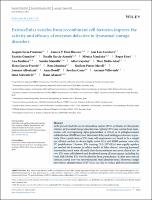| dc.contributor | Vall d'Hebron Barcelona Hospital Campus |
| dc.contributor.author | Diaz Riascos, Zamira Vanessa |
| dc.contributor.author | Corchero Nieto, José Luis |
| dc.contributor.author | González Callejo, Patricia |
| dc.contributor.author | Garcia Aranda, Natalia |
| dc.contributor.author | Mandaña Solé, Mònica |
| dc.contributor.author | BOULLOSA GOBERNA, ANA MARIA |
| dc.contributor.author | Mancilla-Zamora, Sandra |
| dc.contributor.author | Grayston, Alba |
| dc.contributor.author | Moltó Abad, Marc |
| dc.contributor.author | Pintos-Morell, Guillem |
| dc.contributor.author | Rosell Novel, Anna |
| dc.contributor.author | Schwartz Navarro, Simon |
| dc.contributor.author | Abasolo, Ibane |
| dc.contributor.author | Seras-Franzoso, Joaquin |
| dc.date.accessioned | 2021-07-27T11:03:33Z |
| dc.date.available | 2021-07-27T11:03:33Z |
| dc.date.issued | 2021-03 |
| dc.identifier.citation | Seras‐Franzoso J, Díaz‐Riascos ZV, Corchero JL, González P, García‐Aranda N, Mandaña M, et al. Extracellular vesicles from recombinant cell factories improve the activity and efficacy of enzymes defective in lysosomal storage disorders. J Extracell Vesicles. 2021 Mar;10(5):e12058. |
| dc.identifier.issn | 2001-3078 |
| dc.identifier.uri | https://hdl.handle.net/11351/6205 |
| dc.description | N‐sulfoglucosamine sulfohydrolase; Enzyme replacement therapy; Lysosomal storage disorders |
| dc.description.abstract | In the present study the use of extracellular vesicles (EVs) as vehicles for therapeutic enzymes in lysosomal storage disorders was explored. EVs were isolated from mammalian cells overexpressing alpha-galactosidase A (GLA) or N-sulfoglucosamine sulfohydrolase (SGSH) enzymes, defective in Fabry and Sanfilippo A diseases, respectively. Direct purification of EVs from cell supernatants was found to be a simple and efficient method to obtain highly active GLA and SGSH proteins, even after EV lyophilization. Likewise, EVs carrying GLA (EV-GLA) were rapidly uptaken and reached the lysosomes in cellular models of Fabry disease, restoring lysosomal functionality much more efficiently than the recombinant enzyme in clinical use. In vivo, EVs were well tolerated and distributed among all main organs, including the brain. DiR-labelled EVs were localized in brain parenchyma 1 h after intra-arterial (internal carotid artery) or intravenous (tail vein) administrations. Moreover, a single intravenous administration of EV-GLA was able to reduce globotriaosylceramide (Gb3) substrate levels in clinically relevant tissues, such kidneys and brain. Overall, our results demonstrate that EVs from cells overexpressing lysosomal enzymes act as natural protein delivery systems, improving the activity and the efficacy of the recombinant proteins and facilitating their access to organs neglected by conventional enzyme replacement therapies. |
| dc.language.iso | eng |
| dc.publisher | Wiley |
| dc.relation.ispartofseries | Journal of Extracellular Vesicles;10(5) |
| dc.rights | Attribution 4.0 International |
| dc.rights.uri | http://creativecommons.org/licenses/by/4.0/ |
| dc.source | Scientia |
| dc.subject | Metabolisme - Trastorns |
| dc.subject | Enzims extracel·lulars - Ús terapèutic |
| dc.subject.mesh | Lysosomal Storage Diseases |
| dc.subject.mesh | Extracellular Vesicles |
| dc.subject.mesh | /enzymology |
| dc.title | Extracellular vesicles from recombinant cell factories improve the activity and efficacy of enzymes defective in lysosomal storage disorders |
| dc.type | info:eu-repo/semantics/article |
| dc.identifier.doi | 10.1002/jev2.12058 |
| dc.subject.decs | enfermedades por almacenamiento lisosómico |
| dc.subject.decs | vesículas extracelulares |
| dc.subject.decs | /enzimología |
| dc.relation.publishversion | https://onlinelibrary.wiley.com/doi/10.1002/jev2.12058 |
| dc.type.version | info:eu-repo/semantics/publishedVersion |
| dc.audience | Professionals |
| dc.contributor.organismes | Institut Català de la Salut |
| dc.contributor.authoraffiliation | [Seras-Franzoso J, González P, Schwartz S Jr] Drug Delivery & Targeting, CIBBIM-Nanomedicine, Vall d’Hebron Institut de Recerca (VHIR), Barcelona, Spain. Universitat Autònoma de Barcelona, Bellaterra, Spain. Networking Research Center on Bioengineering, Biomaterials and Nanomedicine (CIBER-BBN), Barcelona, Spain. [Díaz-Riascos ZV, García-Aranda N, Mandaña M, Boullosa A, Mancilla S, Abasolo I] Drug Delivery & Targeting, CIBBIM-Nanomedicine, Vall d’Hebron Institut de Recerca (VHIR), Barcelona, Spain. Universitat Autònoma de Barcelona, Bellaterra, Spain. Networking Research Center on Bioengineering, Biomaterials and Nanomedicine (CIBER-BBN), Barcelona, Spain. Functional Validation & Preclinical Research (FVPR), CIBBIM-Nanomedicine, Vall d’Hebron Institut de Recerca (VHIR), Barcelona, Spain. Universitat Autònoma de Barcelona, Bellaterra, Spain. [Corchero JL] Networking Research Center on Bioengineering, Biomaterials and Nanomedicine (CIBER-BBN), Barcelona, Spain. Institut de Biotecnologia i de Biomedicina (IBB) and Department of Genetics and Microbiology, Universitat Autònoma de Barcelona, Bellaterra, Spain. [Grayston A, Rosell A] Neurovascular Research Laboratory, Vall d’Hebron Institut de Recerca (VHIR), Barcelona, Spain. Universitat Autònoma de Barcelona, Bellaterra, Spain. [Moltó-Abad M, Pintos-Morell G] Drug Delivery & Targeting, CIBBIM-Nanomedicine, Vall d’Hebron Institut de Recerca (VHIR), Barcelona, Spain. Universitat Autònoma de Barcelona, Bellaterra, Spain. Division of Rare Diseases, Reference Center for Hereditary Metabolic Disorders (CSUR, XUEC, MetabERN, and CIBER-ER). Vall d’Hebron Hospital Universitari, Barcelona, Spain |
| dc.identifier.pmid | 33738082 |
| dc.identifier.wos | 000632839300005 |
| dc.relation.projectid | info:eu-repo/grantAgreement/ES/PE2013-2016/PI18%2F00871 |
| dc.rights.accessrights | info:eu-repo/semantics/openAccess |

